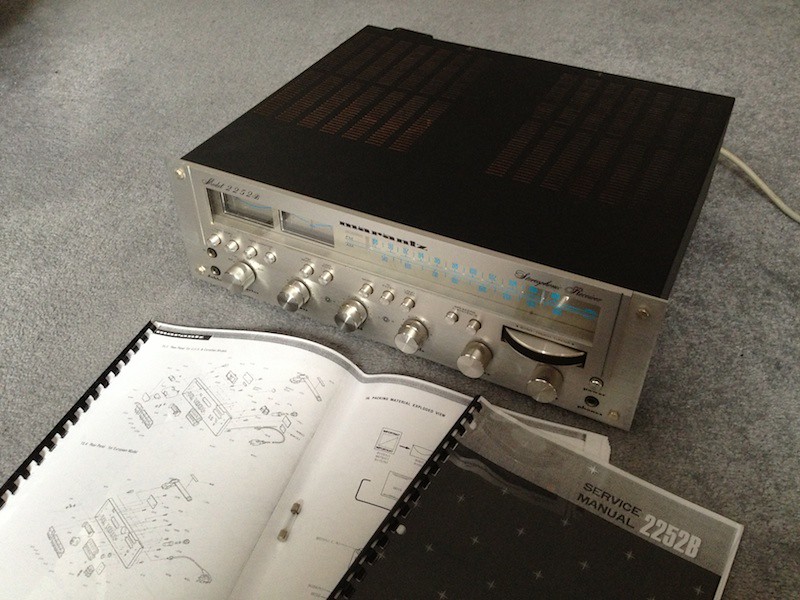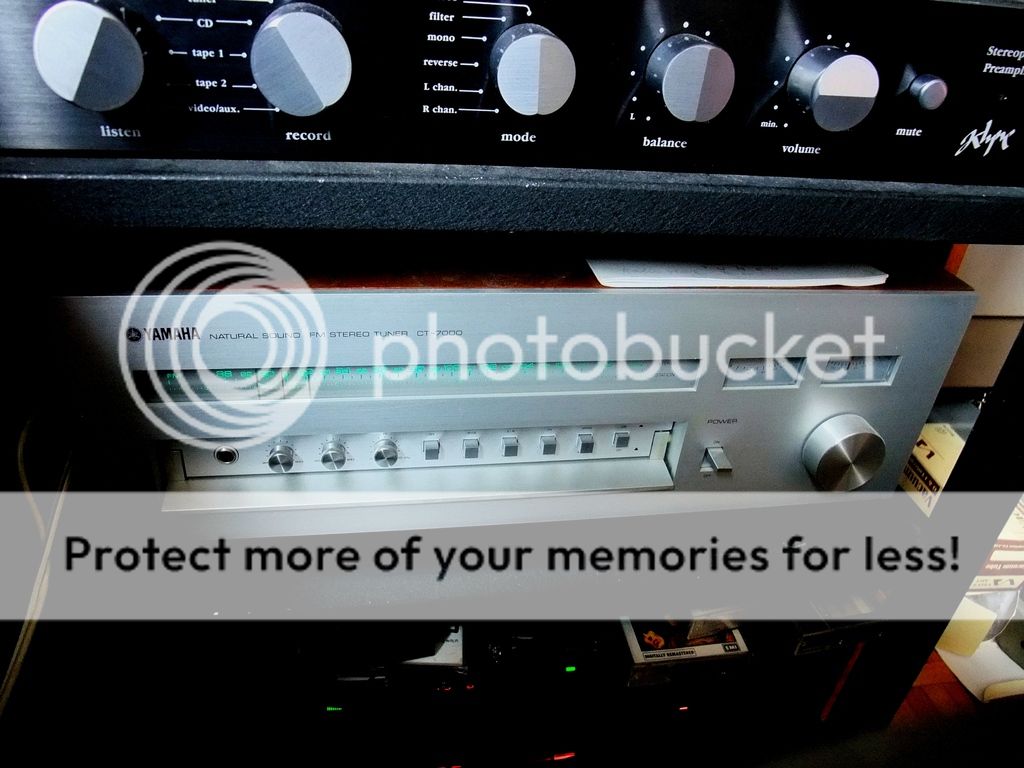ff1d1l
pfm Member
Onkyo Integra 9090ii

From the Tuner information centre:
With the exception of the very rare Grand Integra T-G10, the T-9090 and T-9090II were the best tuners ever made by Onkyo. The T-9090 is "almost" the equal of its successor for sensitivity and selectivity, and both have the digital equivalent of 6 gangs. However, the T-9090II has 9 ceramic filters to the T-9090's 7, and the T-9090II tunes in .025 MHz steps (which can be useful for detuning away from a strong local station) rather than in .2 steps like the T-9090 does (which allows one to tune up and down the dial more quickly). In addition, the T-9090II has a remote control, two antenna inputs that can be A/B'd, and a few other minor features that the T-9090 lacks. Both tuners have 20 presets and digital signal strength readouts, among other bells and whistles.
The most significant feature of the T-9090 and T-9090II (which can also be found in other tuners in Onkyo's Integra line) is the "APR" (automatic precision reception) system which automatically selects the optimal IF bandwidth, RF mode, stereo or mono, and whether or not to use the hi-blend filter, based upon the characteristics of the tuned signal. The T-9090II's APR system also chooses between Antenna A or B for best reception. Both Onkyos are superb DX machines, and as digital tuners are surpassed for adjacent channel reception only by the Sony XDR-F1HD and possibly a modified Yamaha T-85 (due to the T-85's .01 MHz fine-tuning capability). The Onkyos are really selective enough without modification - especially the T-9090II, which uses five 150 kHz filters in its Super Narrow IF mode. Although this spec does not appear in Onkyo's U.S. product manuals, Australian DXer Todd Emslie reports that the T-9090II's adjacent channel selectivity is 45 dB.
The T-9090 and T-9090II are both very quiet on weak signals and their stereo separation, while not "world class," is not bad even in Super Narrow mode. Our panelist Bob observes, "In general, most tuners' stock blend circuits stink. I have gotten pretty sensitive to any noise, and usually have to go right to mono. The T-9090II has a good stock blend circuit, better than most tuners have." Some people dislike the Onkyos' ergonomics - both have tiny buttons that are not all grouped logically - but they're very solidly built tuners and not at all "plasticky."
Our panelist Eric recently unearthed the description of a 1988 shootout between his T-9090 and Paul M.'s T-9090II: "We hooked the T-9090 and T-9090II to the same antenna, with the same connections, and later reversed them to make sure things were equal. The T-9090II was very slightly more selective. There were only a couple of cases where it mattered at all, because I have one 105-120 dB local and no others over 60 dB when peaked. So there was no great improvement in reception of adjacent channels. But, surprise: the T-9090 was very noticeably quieter. Not by much, but consistently, up and down the dial, for any weak station. So a weak (i.e., less than 15-20 dB) station next to a strong local would be heard with less 'slop' and 'crash,' but with more 'fuzz,' stereo or not, on the T-9090II. Our conclusion: Anyone who has a choice should choose a T-9090 if they're not troubled by very strong locals (over 60 or so dB). Anyone in close proximity to locals might welcome the T-9090II as a small but noticeable improvement in adjacent-channel selectivity.

From the Tuner information centre:
With the exception of the very rare Grand Integra T-G10, the T-9090 and T-9090II were the best tuners ever made by Onkyo. The T-9090 is "almost" the equal of its successor for sensitivity and selectivity, and both have the digital equivalent of 6 gangs. However, the T-9090II has 9 ceramic filters to the T-9090's 7, and the T-9090II tunes in .025 MHz steps (which can be useful for detuning away from a strong local station) rather than in .2 steps like the T-9090 does (which allows one to tune up and down the dial more quickly). In addition, the T-9090II has a remote control, two antenna inputs that can be A/B'd, and a few other minor features that the T-9090 lacks. Both tuners have 20 presets and digital signal strength readouts, among other bells and whistles.
The most significant feature of the T-9090 and T-9090II (which can also be found in other tuners in Onkyo's Integra line) is the "APR" (automatic precision reception) system which automatically selects the optimal IF bandwidth, RF mode, stereo or mono, and whether or not to use the hi-blend filter, based upon the characteristics of the tuned signal. The T-9090II's APR system also chooses between Antenna A or B for best reception. Both Onkyos are superb DX machines, and as digital tuners are surpassed for adjacent channel reception only by the Sony XDR-F1HD and possibly a modified Yamaha T-85 (due to the T-85's .01 MHz fine-tuning capability). The Onkyos are really selective enough without modification - especially the T-9090II, which uses five 150 kHz filters in its Super Narrow IF mode. Although this spec does not appear in Onkyo's U.S. product manuals, Australian DXer Todd Emslie reports that the T-9090II's adjacent channel selectivity is 45 dB.
The T-9090 and T-9090II are both very quiet on weak signals and their stereo separation, while not "world class," is not bad even in Super Narrow mode. Our panelist Bob observes, "In general, most tuners' stock blend circuits stink. I have gotten pretty sensitive to any noise, and usually have to go right to mono. The T-9090II has a good stock blend circuit, better than most tuners have." Some people dislike the Onkyos' ergonomics - both have tiny buttons that are not all grouped logically - but they're very solidly built tuners and not at all "plasticky."
Our panelist Eric recently unearthed the description of a 1988 shootout between his T-9090 and Paul M.'s T-9090II: "We hooked the T-9090 and T-9090II to the same antenna, with the same connections, and later reversed them to make sure things were equal. The T-9090II was very slightly more selective. There were only a couple of cases where it mattered at all, because I have one 105-120 dB local and no others over 60 dB when peaked. So there was no great improvement in reception of adjacent channels. But, surprise: the T-9090 was very noticeably quieter. Not by much, but consistently, up and down the dial, for any weak station. So a weak (i.e., less than 15-20 dB) station next to a strong local would be heard with less 'slop' and 'crash,' but with more 'fuzz,' stereo or not, on the T-9090II. Our conclusion: Anyone who has a choice should choose a T-9090 if they're not troubled by very strong locals (over 60 or so dB). Anyone in close proximity to locals might welcome the T-9090II as a small but noticeable improvement in adjacent-channel selectivity.









